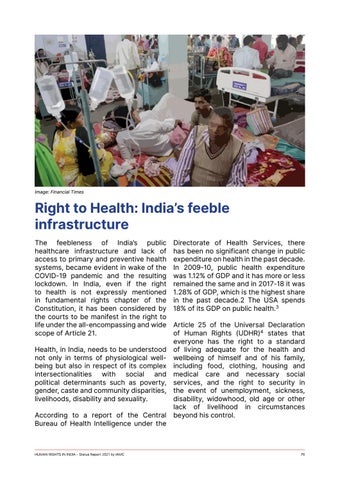Image: Financial Times
Right to Health: India’s feeble infrastructure The feebleness of India’s public healthcare infrastructure and lack of access to primary and preventive health systems, became evident in wake of the COVID-19 pandemic and the resulting lockdown. In India, even if the right to health is not expressly mentioned in fundamental rights chapter of the Constitution, it has been considered by the courts to be manifest in the right to life under the all-encompassing and wide scope of Article 21. Health, in India, needs to be understood not only in terms of physiological wellbeing but also in respect of its complex intersectionalities with social and political determinants such as poverty, gender, caste and community disparities, livelihoods, disability and sexuality. According to a report of the Central Bureau of Health Intelligence under the
HUMAN RIGHTS IN INDIA - Status Report 2021 by IAMC
Directorate of Health Services, there has been no significant change in public expenditure on health in the past decade. In 2009-10, public health expenditure was 1.12% of GDP and it has more or less remained the same and in 2017-18 it was 1.28% of GDP, which is the highest share in the past decade.2 The USA spends 18% of its GDP on public health.3 Article 25 of the Universal Declaration of Human Rights (UDHR)4 states that everyone has the right to a standard of living adequate for the health and wellbeing of himself and of his family, including food, clothing, housing and medical care and necessary social services, and the right to security in the event of unemployment, sickness, disability, widowhood, old age or other lack of livelihood in circumstances beyond his control.
76
